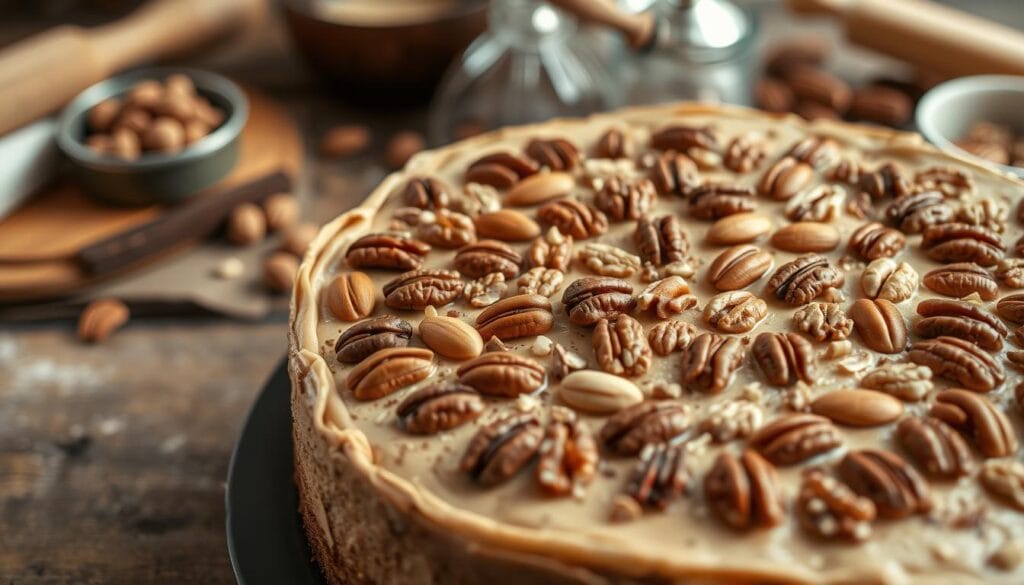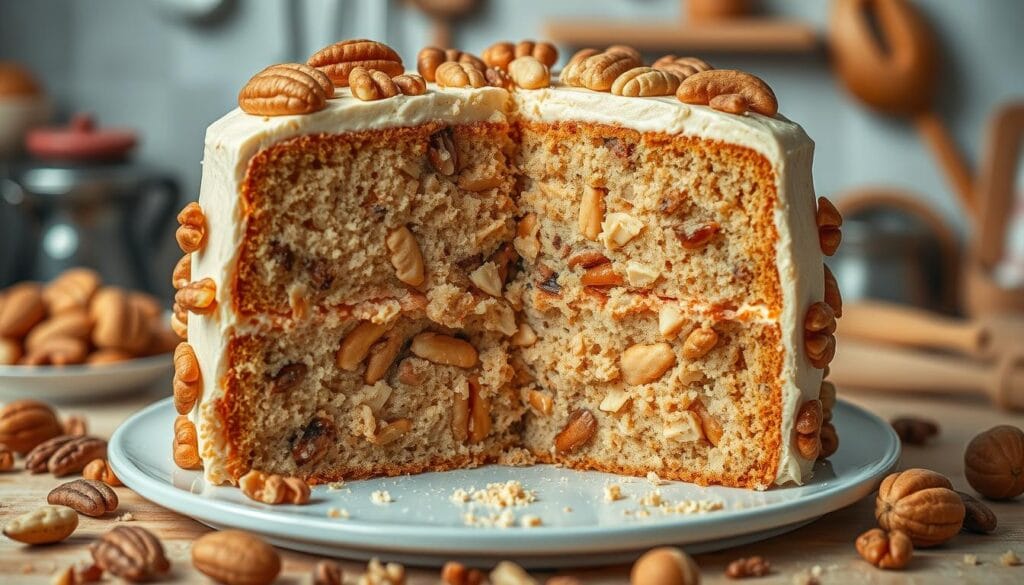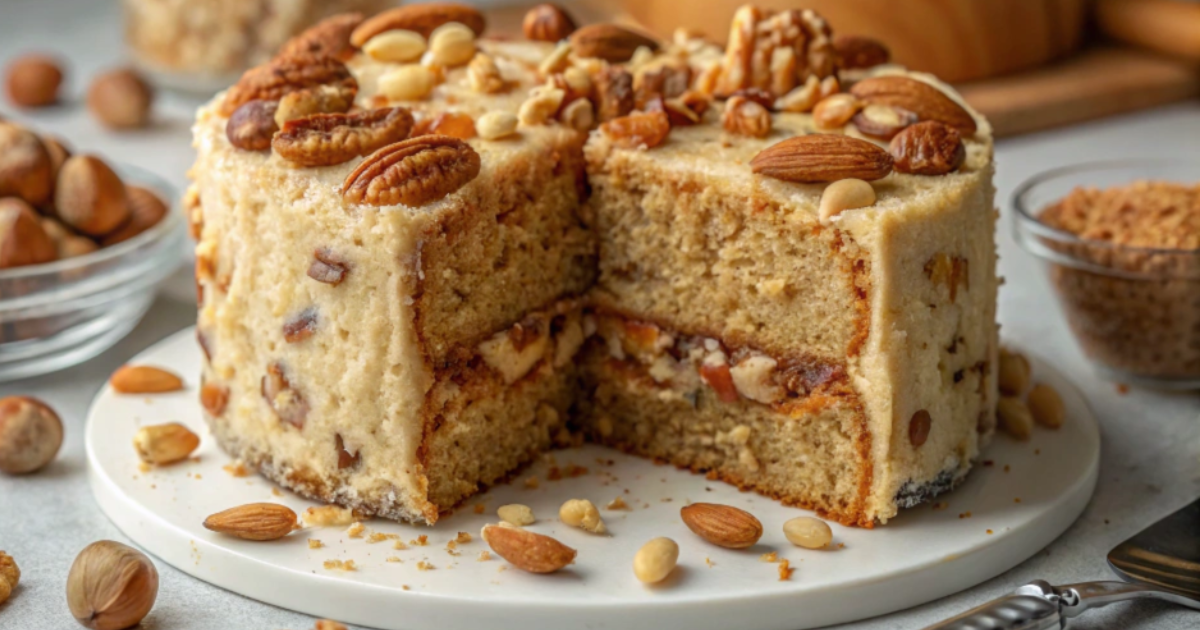Baking a cake with nuts is a fun and rewarding process, but achieving even nut distribution can be challenging. How do you keep your nuts from sinking in a cake? By using techniques like coating the nuts in flour, ensuring the batter is the right consistency, and folding them in gently, you can create a cake with perfectly suspended nuts for a beautiful texture and exceptional flavor.

Table of Contents
The Science Behind Keeping Nuts from Sinking in Cakes
Ever wondered why nuts in cakes often sink to the bottom? It’s all about the science. Let’s dive into what makes nuts behave this way.
Density and Weight Distribution
Nuts like almonds, walnuts, or pecans are denser than cake batter. This density difference makes them sink to the bottom. The heavier nuts push the lighter batter aside, creating a nutty layer at the cake’s base.
Temperature Effects on Batter Consistency
The batter’s temperature affects nut distribution too. When baking, the batter’s thickness changes. At first, it’s thin, letting nuts sink easily. But as it cooks, it thickens, making nuts harder to sink, for a more even spread.
Role of Flour Types in Nut Distribution
The type of flour used impacts nut distribution. Flours with more protein, like all-purpose or bread flour, create a thicker batter. This helps nuts stay suspended. But flours with less protein, like almond flour, make a thinner batter. This makes it harder for nuts to stay afloat, leading to a nutty bottom layer.
Knowing these scientific principles helps you manage nut distribution in cakes. This ensures a more even and appealing nut distribution.

Essential Tips to Keep Your Nuts from Sinking in a Cake-How to Keep Nuts from Sinking in Cake Batter
Getting nuts evenly spread in your cakes can be fun for bakers. There are ways to stop nuts from sinking to the bottom. Here are some key tips to help you master nut suspension in your baking.
- Pre-coat the Nuts: Dusting nuts with flour or cornstarch helps them stay in place. This creates a barrier that stops them from sinking.
- Toss Nuts in Batter: Instead of just folding nuts into batter, toss them gently. This ensures they’re spread out evenly, preventing them from clumping.
- Use Batter Consistency: The batter’s thickness is crucial. Thicker batter is better at keeping nuts up than thin batter. Adjust your recipe to get it just right.
| Technique | Description | Benefit |
|---|---|---|
| Nut Coating | Lightly coating nuts in flour or cornstarch | Helps nuts maintain their position in the batter |
| Tossing Nuts | Gently tossing nuts into the batter | Promotes even nut distribution throughout the cake |
| Batter Consistency | Maintaining a thick, viscous batter | Reduces the likelihood of nuts sinking to the bottom |
Using these simple techniques will help you bake cakes with perfectly placed nuts. Your guests will love the texture. Happy baking!
Testing Batter Consistency to Keep Nuts from Sinking-How to Keep Nuts from Sinking in Cake Batter
Baking cakes with nuts requires the right batter consistency. The perfect thickness prevents nuts from sinking. We’ll cover how to test batter thickness and the best mixing techniques for even nut distribution.
Testing Batter Thickness
To prevent nuts from sinking, aim for a thick, pourable batter. Test the thickness by dipping a spoon into the batter. The batter should drip off slowly, leaving a thick trail. If it’s too thin, it won’t hold the nuts well.
Mixing Techniques for Optimal Results
Choosing the right mixing method is key for nut-based cakes. Gentle folding is best to avoid breaking nuts and creating air pockets. Mix the nuts in last, after all other ingredients are combined. This helps them stay evenly distributed.
Understanding the importance of cake batter consistency and mastering mixing methods for nut-based cake recipes ensures even nut distribution. This creates a delightful texture and flavor in every bite.
How to Keep Nuts from Sinking in Cake Batter?
Keeping nuts evenly spread in your cake batter can be tricky. But, with a few easy tips, you can stop nuts from sinking. Let’s look at some nut suspension methods and cake baking tricks to get that perfect, even nut distribution.
Start with the right batter consistency. A thicker batter is better at keeping nuts up. Adjust your recipe’s flour-to-liquid ratio to get the right thickness.
Toss the nuts in a bit of flour before adding them to the batter. This helps the nuts stick to the batter and stay suspended.
Gently fold the nuts into the batter, not vigorously. Too much mixing can make the nuts sink too soon.
Try mixing different nut types, like chopped almonds and walnuts. Their varied sizes and shapes help with even distribution.
Bake the cake at a slightly lower temperature, around 325°F (165°C). This prevents the edges from setting too fast and trapping nuts at the bottom.
With a bit of trial and error, you’ll master the art of keeping nuts perfectly in your cakes. Your taste buds and guests will love it.
“The key to keeping nuts from sinking is all about finding the right balance in your cake batter.”
Proper Nut Preparation Techniques-How to Keep Nuts from Sinking in Cake Batter
When baking cakes with nuts, getting them right is crucial. This means using the right coating methods and chopping sizes. These steps help nuts spread evenly in your batter.
Coating Methods
Coating nuts before adding them to batter can prevent sinking. Use a bit of flour or cornstarch to coat them. This helps the nuts stick to the batter, keeping them from sinking.
- Flour Coating: Toss the chopped nuts in a few tablespoons of all-purpose flour until they are evenly coated.
- Cornstarch Coating: Mix the chopped nuts with a teaspoon or two of cornstarch, ensuring the nuts are lightly coated.
Size and Chopping Guidelines
The size of nut pieces is key for even distribution. Smaller, uniform pieces stay suspended in the batter. This prevents them from sinking to the bottom.
- Chop the nuts into small, bite-sized pieces, approximately 1/4 to 1/2 inch in size.
- Use a sharp knife or a food processor to achieve the desired nut size and consistency.
- Avoid chopping the nuts too finely, as they may become too small and disappear into the batter.
By using these nut preparation techniques, your cake will have nuts evenly spread. This adds a delightful texture and flavor to every bite.
Common Mistakes When Adding Nuts to Cake Batter-How to Keep Nuts from Sinking in Cake Batter
Baking cakes with nuts can be tricky. It’s easy to make mistakes that lead to uneven nut distribution or sunken nuts. Knowing the common pitfalls can help you avoid these baking errors and ensure your nut distribution problems are a thing of the past. Let’s explore the most common cake baking troubleshooting issues when it comes to incorporating nuts into your batters.
- Failing to Properly Prepare the Nuts:Neglecting to toast, chop, or coat the nuts before adding them to the batter can result in the nuts sinking to the bottom of the cake.
- Incorrect Batter Consistency: If the batter is too thin, the nuts will simply fall through, while a batter that’s too thick can prevent the nuts from dispersing evenly.
- Improper Nut-to-Batter Ratio: Adding too many nuts compared to the amount of batter can cause the nuts to clump together and sink.
- Mixing the Nuts in Too Early: Folding the nuts into the batter too soon can cause them to sink before the baking process even begins.
- Skipping the Flour Dusting: Not coating the nuts with a light dusting of flour before adding them to the batter can inhibit their ability to stay suspended.
By being mindful of these common baking errors, nut distribution problems, and cake baking troubleshooting issues, you can ensure your nut-based cakes turn out beautifully every time. They will have evenly distributed, moist, and flavorful nuts throughout.
| Common Mistake | Potential Impact | Solution |
|---|---|---|
| Failing to Properly Prepare Nuts | Nuts sink to the bottom of the cake | Toast, chop, and coat nuts before adding to batter |
| Incorrect Batter Consistency | Nuts fall through thin batter or get trapped in thick batter | Adjust batter thickness to the appropriate consistency |
| Improper Nut-to-Batter Ratio | Nuts clump together and sink | Use the correct ratio of nuts to batter |
| Mixing Nuts in Too Early | Nuts sink before baking | Fold nuts into batter just before pouring into pan |
| Skipping Flour Dusting | Nuts struggle to stay suspended in batter | Lightly coat nuts with flour before adding to batter |
Achieving Perfectly Nut-Filled Cakes Every Time
By addressing these common baking errors, nut distribution problems, and cake baking troubleshooting issues, you’ll be well on your way to creating beautiful, nut-filled cakes. These cakes will impress your family and friends.
Best Types of Nuts for Different Cake Recipes-How to Keep Nuts from Sinking in Cake Batter
Choosing the right nuts can change a cake from good to great. Whether you’re making an almond cake or trying new nuts, knowing what each nut adds is key.
Flavor Combinations
Almonds are perfect for almond cakes because of their nutty taste. Adding almond extract or sliced almonds on top can make it even better. Walnuts, with their earthy flavor, are great with chocolate cakes. Pecans and hazelnuts add unique tastes that make cakes even more special.
Texture Considerations
- Almonds and pecans add a nice crunch, perfect for moist cakes.
- Walnuts and hazelnuts have a chewier texture, great for lighter cakes.
- For denser cakes, use coarsely chopped nuts for a better bite.
- Almond flour can be used to improve the cake texture.
Trying different nuts can make your cakes amazing. Match the right nuts with your cake, and you’ll get a treat that everyone will love.
Alternative Flours and Their Impact on Nut Distribution-How to Keep Nuts from Sinking in Cake Batter
Exploring baking can lead you to try gluten-free flours like almond flour. These flours can bring new tastes and textures to your cakes. But, they can also affect how nuts spread out in the batter.
Almond flour baking is getting more popular for its gluten-free benefits. Yet, almond flour is denser and coarser than regular flour. This makes it harder to mix nuts evenly into the batter, as they might settle at the bottom while baking.
| Flour Type | Nut Distribution Impact | Recommended Techniques |
|---|---|---|
| Almond Flour | Increased risk of nuts sinking due to higher density | Coat nuts in flour before folding into batter Increase batter thickness to provide better suspension Carefully monitor baking time and temperature |
| Coconut Flour | Lighter texture can help distribute nuts more evenly | Reduce overall flour amount to prevent a dry, crumbly texture Experiment with nut types and sizes to find the best balance Adjust liquid ingredients to maintain the desired batter consistency |
Knowing how alternative flours work with nuts can help you make better cakes. Try different methods and amounts to get the nuts just right in your cakes.
“Baking with alternative flours requires a delicate balance, but the results can be truly spectacular when you get it right.”
Temperature and Timing Considerations for Nut-Based Cakes-How to Keep Nuts from Sinking in Cake Batter
Baking nut-based cakes requires careful attention to temperature and timing. Getting it right can make your cake moist and even. But, if you’re off, the nuts might end up at the bottom.
Optimal Baking Temperatures
The best temperature for baking nut-based cakes is between 325°F and 350°F. This range helps the batter stay right, keeping the nuts from sinking. It also ensures the cake bakes evenly.
Baking too low can make the cake dense and soggy. On the other hand, baking too high can burn the nuts or overcook the cake.
Testing for Doneness
- Using a toothpick or cake tester is the best way to check if a nut-based cake is done. It should come out clean when inserted into the center.
- You can also press the cake’s top gently with your finger. If it springs back, it’s ready.
- Remember, nut-based cakes take longer to bake. This is because the nuts add moisture and density.
Knowing the right baking temperature and testing for doneness is key. It ensures your nut-based cakes are perfectly baked. They’ll have the nuts spread out evenly in a moist, tasty crumb.
Professional Baker’s Secrets for Perfect Nut Distribution-How to Keep Nuts from Sinking in Cake Batter
As a professional baker, I’ve picked up some tricks for perfect nut distribution in cakes. Whether you’re making a rich nut-filled dessert or want to avoid sinking nuts, these expert tips will boost your baking skills.
Mastering Nut Coating Techniques
Preventing nuts from sinking starts with proper preparation. Lightly coat your nuts with flour or cornstarch. This creates a barrier that keeps the nuts floating in the batter. Gently toss the nuts to spread the coating evenly.
Adjusting Batter Consistency
The batter’s consistency is key for nut distribution. A thick, creamy batter is best for keeping nuts afloat. Try adding ground nuts or almond flour to the batter. This boosts the nut flavor and thickens the batter to support the nuts.
Timing is Everything
Timing is crucial when adding nuts to the batter. For the best results, fold in the nuts just before pouring the batter into the pan. This ensures the nuts stay evenly distributed and don’t sink.
| Baking Tip | Explanation |
|---|---|
| Coat nuts in flour or cornstarch | Creates a barrier to prevent sinking |
| Use ground nuts or almond flour in batter | Thickens the batter for better nut suspension |
| Fold in nuts at the last minute | Minimizes time for nuts to sink |
By using these professional cake techniques and nut suspension tricks, you’ll make cakes with perfectly distributed nuts. These baking tips from experts will elevate your nut-based creations.
Conclusion-How to Keep Nuts from Sinking in Cake Batter
In this article, you’ve learned the science behind nut distribution in cakes. You now know how to keep your nuts from sinking. By understanding density, temperature, and flour types, you can make the perfect batter.
With the tips and tricks shared, you can make cakes with evenly distributed nuts. This is thanks to the right nut preparation and baking temperatures. The secret is balancing ingredients, mixing methods, and temperature control.
Now, you’re ready to improve your cake-baking skills. Use these strategies to make cakes that impress everyone. Your family and friends will love the texture and look of your nut-based cakes.
FAQ-How to Keep Nuts from Sinking in Cake Batter
Why is almond flour so hard to bake with?
Almond flour is a tasty alternative to wheat flour but can be tricky to use. It’s denser and oilier, changing how baked goods turn out. It also lacks gluten, making it hard to get the right texture and rise in cakes and breads. You need to adjust recipes and baking methods when using almond flour.
What flavors go well with almond cake?
Almond cake is great with many flavors. Try pairing it with citrus, stone fruits, berries, vanilla, chocolate, or spices like cinnamon. The nutty taste of almond cake is perfect for these flavors, making for tasty desserts.
How do you keep your nuts from sinking in a cake?
To stop nuts from sinking, try these tips: – Coat nuts in flour before adding them to the batter. – Make the batter thicker by using less liquid. – Fold nuts gently into the batter. – Chill the batter for 30 minutes to help it hold the nuts. – Bake at a lower temperature for longer to set the batter around the nuts. These steps help nuts stay evenly spread in your cake.
What is the downside of almond flour?
Almond flour has some drawbacks: – It makes baked goods denser and coarser than wheat flour. – Its strong nutty flavor can overpower other tastes. – It absorbs more moisture, making it hard to get the right texture. – It’s pricier than wheat flour, adding to baking costs. – It has a shorter shelf life and can spoil quickly if not stored right.


1 thought on “How to keep nuts from sinking in cake batter”